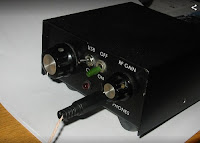Posts Tagged ‘15m’
 Pipit – 15m QRP CW transceiver
Pipit – 15m QRP CW transceiver
Many years ago I designed and built the Pipit, an 800mW CW transceiver with a direct conversion receiver. It really worked and for some time was my main rig. Used with a low dipole it worked some decent DX. The design was published in GQRP “SPRAT” many years ago.
Sadly, the rig was dismantled some years later. I regret this!
 Pipit 15m transceiver
Pipit 15m transceiver
This rig was designed and built many years ago. It spanned some impressive distances and worked well. The receiver was a direct conversion and the gain adjustment was before the mixer, so RF gain could be reduced easily which helped strong signal handling. No RX-TX offset was needed as this was just about right anyway. For quite a time it was the main rig used and every QSO felt like a million dollars! It was written up in GQRP SPRAT a very long time ago (30 years ago?). It is hard to get much more fun than using something this simple and working a long way regularly with it.
Before I had crystals for the CW part of the band my very first QSO was a USA SSB station that I called that was located near Chicago some 4000 miles away. I nearly fell off the chair when he replied. After than I knew anything was possible. I really should rebuild it someday.
It crossed the Atlantic many times. I even used a 10/15m trap dipole (very low) occasionally and never used anything bigger than a low wire dipole. Output power was 800mW, quite enough I found for solid CW QSOs.
 Fun on Fifteen
Fun on Fifteen
I have spent the entire day on 15m, mostly using PSK31. The band has been pretty lively all day. I worked a number of Russian stations including UB3YL Katya from Orel. That’s her picture below. Pity about the corrugated iron roof shadow.
I made a couple of contacts into the Far East. One was with Yasuda JA1OTT, the other was with Chen BG9GYI.
 |
| Youkits TJ2B |
Chen is a university student from Lanzhou. Chinese stations are becoming more common as more and more get on the bands. From the admittedly small sample I have managed to work Chinese hams form a different demographic from those from Europe or the USA. While your average EU or US ham is likely to be older than 60 (judging by those who tell me their age), Chinese hams seem to be mostly young people with an interest in technology.
It’s good, too, to see Chinese firms entering the ham radio market with QRP products such as the kits from Youkits (take a look at the new TJ2B SSB handheld!)
 Far East DX
Far East DX
After yesterday’s disappointing session on 15m PSK31 I tried JT9-1 again. The new JT mode showed its superiority by giving me two contacts with Japan. I nearly worked more as one JA replied to my CQ but disappeared after I sent his report. I was also spotted on HamSpots by two other JAs whom I have never seen on my screen. Another nice contact was with HS0ZBS. This is not the first time I have worked Thailand, but all my contacts with that country have been on 15m.
In another direction I worked PJ2MI – a familiar callsign. Checking my log we first worked in 2003 using PSK63 – quite an achievement as I would have been using my K2 and 4W output. More recently I have worked Jose using PSK31 and JT65A. On 20m I worked K8CZC who from the look of his eQSL would have been using low power (QRP).
 A good session on 15m
A good session on 15m
There was not much life on 10m this morning but 15m was really hopping. I started off using PSK31 and my first QSO was with a Ukrainian YL named Olga! Her call was US5UFF and her QSL shows that she is (X)YL of UR4UHE. I think the UFF stands for Ukrainian Flora and Fauna which seems to be a popular award scheme over in Ukraine.
I was calling CQ and worked a whole string of east European and Russian stations. Calling CQ is a good way to fill the log but not a good way to work much DX as if any DX did reply it would likely be lost under the strong local stations calling.
As the hour approached lunch time I did some search and pouncing and managed to nab HS4ESF from Mahasarakham University in Thailand. I don’t think it’s the first time I have worked Thailand on PSK but it was nice nonetheless, and he has a nice QSL.
I’ve often noticed from my beacon monitoring that the time around midday to lunch time is a good time to work DX on the higher HF bands. I didn’t work any other DX today but I was pleased to see on Propagation Reporter that my 40W of PSK31 to an attic dipole had been decoded near Sydney in Australia! Perhaps I’ll work VK on PSK31 one day!
 |
| PSK31 spots of G4ILO on 15m |
I tried JT65A briefly but the band segment was full of the same stations I could easily work using PSK31 so I thought I would try CW instead. I “shook hands” (as John N8ZYA puts it) with Z320K, a special call to commemorate 20 years of the Z3 prefix (Macedonia.) I then had a real QSO with Bill, WA1HMW who is an ex-Royal Navy. That QSO taxed my receiving abilities a bit so I decided to call it a day.
 Jamming on PSK
Jamming on PSK
I was on 15m PSK31 and in the process of calling PY3ED when a vicious jamming signal started up.
 |
| Jamming on 21MHz |
As you can see, it did a good job of obliterating all signals. It seemed to be centered around 21.070MHz and extended for 50kHz or so in either direction.
I don’t know how long it stayed on for because it was lunch time so I went to have something to eat. When I came back the interfering signal had gone.
Was it something local to me or has anyone else seen it?


















